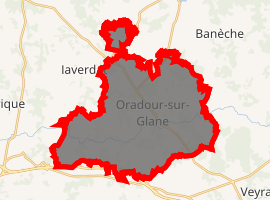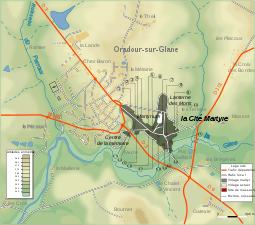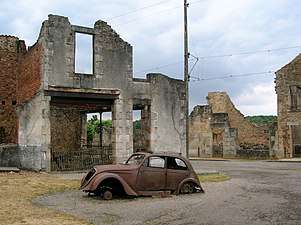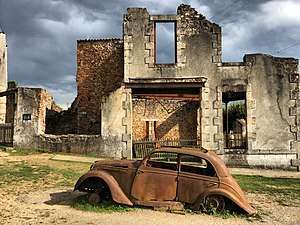Oradour-sur-Glane
Oradour-sur-Glane (Occitan: Orador de Glana) is a commune in the Haute-Vienne department in the Nouvelle-Aquitaine region in west-central France, as well as the name of the main village within the commune.
Oradour-sur-Glane | |
|---|---|
 Oradour-sur-Glane Town Hall | |
 Coat of arms | |
Location of Oradour-sur-Glane 
| |
 Oradour-sur-Glane  Oradour-sur-Glane | |
| Coordinates: 45°55′58″N 1°01′57″E | |
| Country | France |
| Region | Nouvelle-Aquitaine |
| Department | Haute-Vienne |
| Arrondissement | Rochechouart |
| Canton | Saint-Junien |
| Intercommunality | Vienne Glane |
| Government | |
| • Mayor (2014–2020) | Philippe Lacroix |
| Area 1 | 38.16 km2 (14.73 sq mi) |
| Population (2017-01-01)[1] | 2,473 |
| • Density | 65/km2 (170/sq mi) |
| Time zone | UTC+01:00 (CET) |
| • Summer (DST) | UTC+02:00 (CEST) |
| INSEE/Postal code | 87110 /87520 |
| Elevation | 227–312 m (745–1,024 ft) (avg. 285 m or 935 ft) |
| 1 French Land Register data, which excludes lakes, ponds, glaciers > 1 km2 (0.386 sq mi or 247 acres) and river estuaries. | |
History
The original village was destroyed on 10 June 1944, when 642 of its inhabitants, including women and children, were massacred by a company of troops belonging to the 2nd SS Panzer Division Das Reich, a Waffen-SS unit of the military forces of Nazi Germany. A new village was built after the war on a nearby site, but on the orders of the then French president, Charles de Gaulle, the original has been maintained as a permanent memorial. The Centre de la mémoire d'Oradour museum is located beside the historic site.
Personalities linked to the commune
- Robert Hébras, born on 29 June 1925 in Oradour-sur-Glane; one of the six survivors of the Oradour-sur-Glane massacre on 10 June 1944.
- Jean-Claude Peyronnet, (1940–), French politician, creator of the Centre of the Memory of Oradour-sur-Glane.
- Sébastien Puygrenier began his football career at US Oradour-sur-Glane where his father and his uncles played
- Didier Barbelivien, French singer-songwriter, pays tribute to Oradour by his song "Les amants d'Oradour".
Geography
The municipality borders with Javerdat, Cieux, Peyrilhac, Veyrac, Saint-Victurnien and Saint-Brice-sur-Vienne.
Demographics
| 1806 | 1820 | 1876 | 1901 | 1911 | 1921 | 1936 | 1946 | 1954 |
|---|---|---|---|---|---|---|---|---|
| 1,222 | 1,585 | 1,903 | 1,966 | 2,019 | 1,789 | 1,574 | 1,145 | 1,450 |
| 1962 | 1968 | 1975 | 1982 | 1990 | 1999 | 2006 | 2008 | 2012 |
|---|---|---|---|---|---|---|---|---|
| 1,540 | 1,671 | 1,759 | 1,941 | 1,998 | 2,024 | 2,118 | 2,222 | 2,375 |
Gallery
 Map showing modern and former village
Map showing modern and former village Ruined village
Ruined village
References
- "Populations légales 2017". INSEE. Retrieved 6 January 2020.
- Institut national de la statistique et des études économiques. "Population of Oradour-sur-Glane from 1806 to 2008" (PDF). Retrieved 11 July 2011.
Bibliography
- Farmer, Sarah. Martyred Village: Commemorating the 1944 Massacre at Oradour-sur-Glane. University of California Press, 2000.
- Fouché, Jean-Jacques. Massacre At Oradour: France, 1944; Coming To Grips With Terror, Northern Illinois University Press, 2004.
- INSEE
- Penaud, Guy. La "Das Reich" 2e SS Panzer Division (Parcours de la division en France, 560 pp), Éditions de La Lauze/Périgueux. ISBN 2-912032-76-8